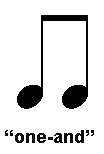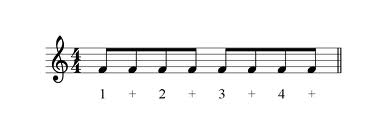Many times when you see two eighth notes together, they are connected by a beam.
This beam is a darkened line that runs horizontally (left to right) to connect the tops of the stems.

The stems can face either up or down. However they appear, you will still treat them in the same way.
Sometimes, you can see 4 eighth notes beamed together that looks like this:

| ✅ The best self-study music theory book loved by all my readers and students. |
Do you ever see more than 4 eighth notes beamed together?
Not really, four eighth notes are the most you will normally see beamed together in 2/4, 3/4, or 4/4 time without any rests in between.
However, you can see 6, 8, or more eighth notes beamed together in 3/8, 6/8, 9/8, or 12/8 time.
Exactly how eighth notes work in different time signatures is a great discussion for another time.
Right now, let’s figure out mathematically how eighth notes are related to other note values.
The Value of Eighth Notes
Eighth notes equal 1/2 a count. Do you know how many eighth notes it takes to equal a quarter note?
Yep, it takes two eighth notes to equal 1 quarter note. (1/2 + 1/2 = 1)
If this doesn’t make sense, try dividing a quarter note in half. The two parts you end up with are a 1/2 (1 single eighth note) and a 1/2 (1 single eighth note).
Together they equal 1 full count or 1 quarter note.
1 half note = four eighth notes
1 whole note = 8 whole notes
How to Count Them

The easiest way to count two eighth notes is by saying “1” for the first eighth note followed by “&” for the second. (“1 – &”)
For 4 eighth notes, you would count it like this “1 – & – 2 – &”

What about 8 eighth notes? This is how you would count those “1 – & – 2 -& – 3 – & – 4 – &”

The number always represents the beat helping you to know what count you are on in the measure.
The “&” is simply a way of sounding the second eighth note evenly in time before the next beat.
If you are tapping your foot, your foot will go down on beat “1” and up on the “&”. This should happen consistently.
Avoid tapping the rhythm (every single eighth note) rather than tapping the beat (numbers only). The foot should always come up on the “&’s” of every beat.
Eighth Notes for Young Children
In elementary grade schools, many music teachers will first teach eighth notes as “ti-ti’s” to young children who are not ready to count them in a more traditional way.
This is genius because students can still experience these types of notes at a young age and do so very accurately.
I have also heard teachers use words such as “jel-lo” or “happ-y” with two syllables to simulate two eighth notes.
Again, this is a great way to first learn these types of notes.
Eventually, you do want to move to counting using the beat (1) followed by “&”.
This is truly the best way to count eighth notes in your head while you are singing or playing an instrument.
If you are counting accurately in your head, you will play the notes perfectly every time.
There is no other trick to counting more complex rhythms. That IS the trick!
In the End
When you see two eighth notes (usually beam together, but sometimes not), count them as “1 – &”. Eighth notes are worth a 1/2 count each.
Therefore, two eighth notes equal a total of 1 whole count.
Don’t let these little “twins” intimidate you. They really are not hard to learn.
Practice tapping your foot and counting them out loud. Do this enough times until you really feel comfortable with this rhythm.
In no time, you will master every eighth note you find in your music.
Recommended Music Theory Books
✅ The best self-study music theory book loved by all my readers and students.
